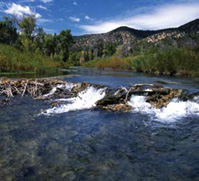Feeding Lanes
A feeding lane is defined as the horizontal extent a fish will move to feed during an insect emergence. A feeding lane’s width varies according to the following factors: hatch intensity, fish’s size, and fish’s dominance. These factors and some general rules will be discussed.
During an intense hatch, such as a trico spinner fall or a blue wing olive emergence, the feeding lanes may become as narrow as 1 or 2 inches in width. A sporadic hatch, such as callibaetis or green drake, may have a much wider feeding lane in excess of 3 feet. This wide variance is linked to the fish’s need to collect the most nutrition with the least amount of energy expenditure. Catching a large green drake merits a longer swim than a tiny trico spinner does.
A fish’s size may determine the feeding lane’s width. Young, smaller fish tend to have wider feeding lanes than older larger fish. This is due to the fish’s experience in energy conservation. An inexperienced fish may pursue every food item without regard to energy expenditure. Also, a smaller fish doesn’t burn up as many calories in catching the same sized insect as a larger fish does. Hence, small fish can feed in wider lanes while larger fish have learned to select productive, narrow lanes in food gathering.
Dominant fish will seek out and overtake the best feeding spots. These positions have access to narrow efficient feeding lanes.
With intimidation, submissive fish are forced to feed in less productive lies which have wider feeding lanes. Consequently, the general rules are that the largest and most dominant fish will occupy the prime feeding lies where they can easily feed from the narrowest feeding lanes. Also, the quantity of available foods can decide the width of the feeding lane. A prime feeding lie is the most efficient feeding area. Here the greatest quantity of insects can be caught with the least amount of work.
With a wider feeding lane the fish must hold deeper. This depth is required because the vision window must be large enough to view the feeding lane. Conversely, shallow holding fish can only view narrow feeding lanes. These factors affect your approach because they influence a fish’s vision and wariness. The size of the feeding lane affects your presentation. The narrower the lanes the more accurate your cast must be to place your fly within this lane. Take a moment and observe a feeding fish to see how far it will venture to catch an insect. Adjust your presentation accordingly.


© 2025 The Gale Group, Inc. All rights reserved.
© 2025 Perigee Learning LLC. All rights reserved.
LoveTheOutdoors.com is owned and operated by Advameg, Inc. © 2025 Advameg, Inc.
Camping Adventures • Dutch Oven Cooking • Sports Knots
Fly Tying • Freshwater Fishing • Fly Fishing

